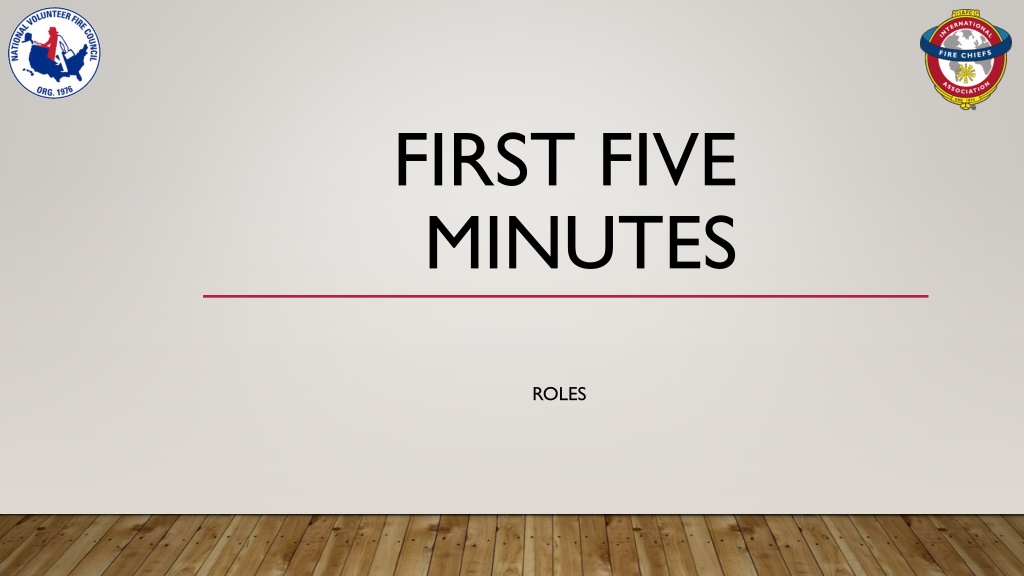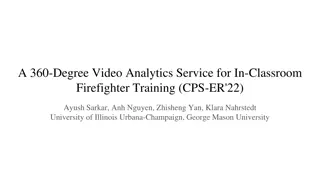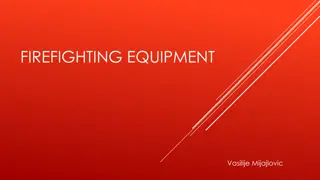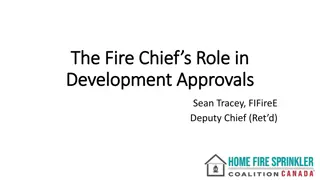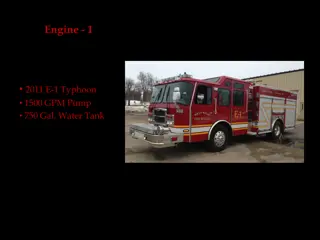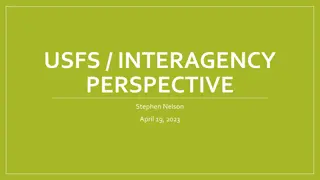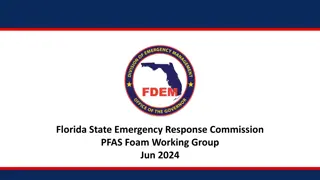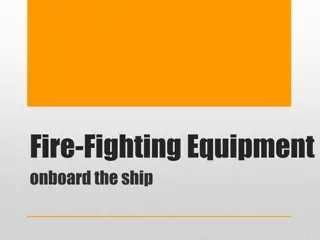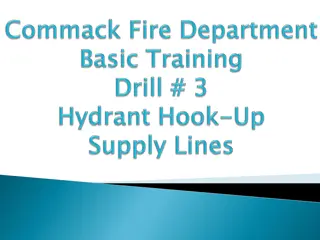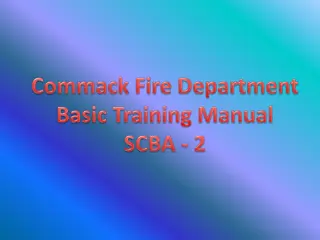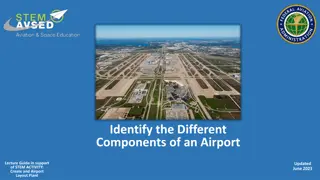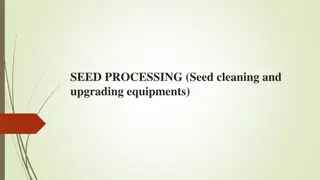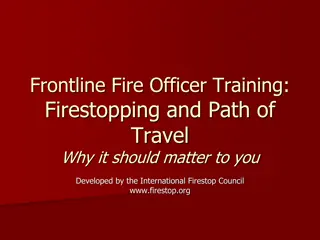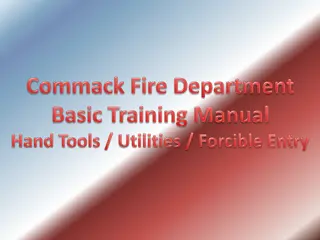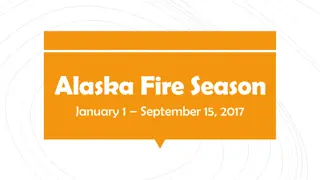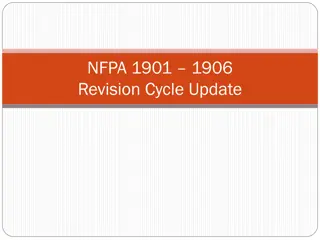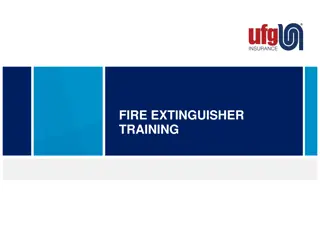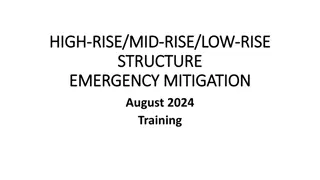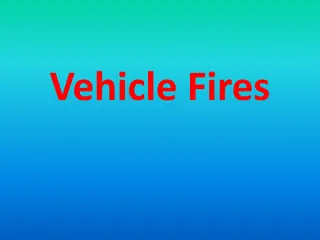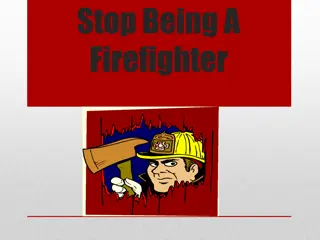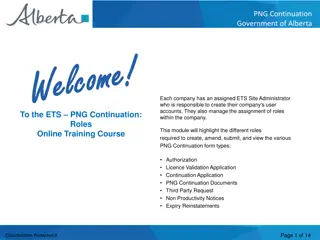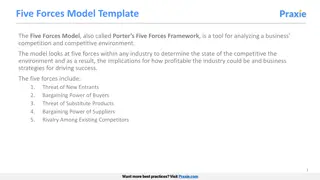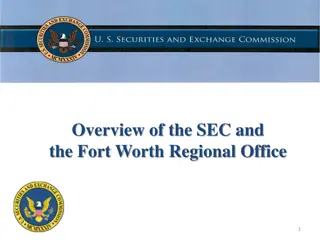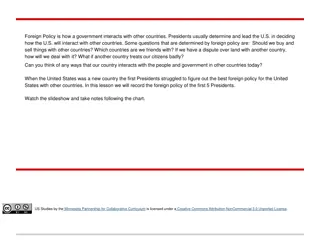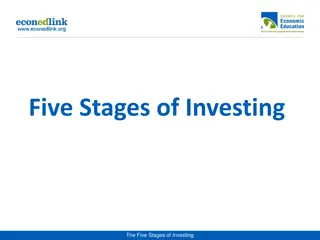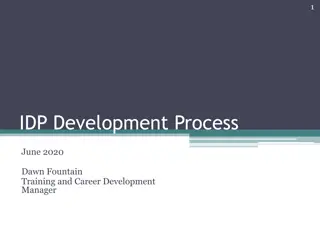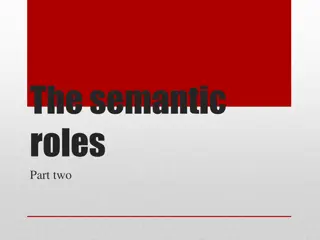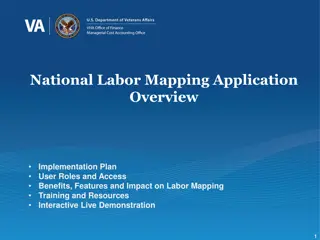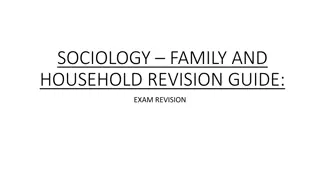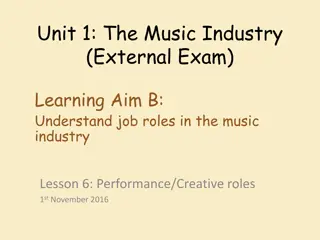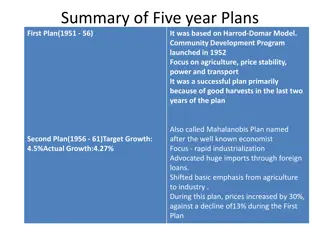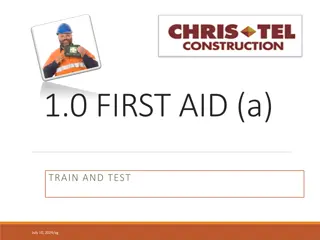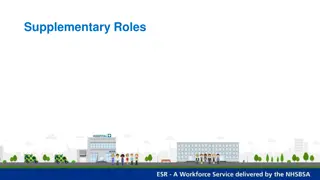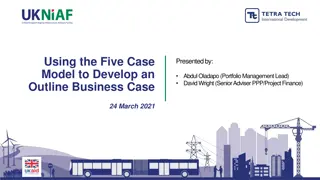Essential Roles in the First Five Minutes of Firefighting
Preparation is vital for success in firefighting, emphasizing the importance of mental and physical fitness, equipment maintenance, and situational awareness. The roles of Company Officers and Command Level Chiefs are crucial in ensuring readiness. Firefighters play a key role in conducting size-ups and assessing risks to ensure a safe approach to emergency situations.
Download Presentation

Please find below an Image/Link to download the presentation.
The content on the website is provided AS IS for your information and personal use only. It may not be sold, licensed, or shared on other websites without obtaining consent from the author. Download presentation by click this link. If you encounter any issues during the download, it is possible that the publisher has removed the file from their server.
E N D
Presentation Transcript
FIRST FIVE MINUTES ROLES
FIRST FIVE MINUTES BEFORE THE TONES
First Five Minutes BEFORE THE TONES Preparation is a key Part of firefighting success Improvising is a worthy attribute Should not be the norm Preparation leads to Better outcomes on incidents outside the norm 3
First Five Minutes BEFORE THE TONES Firefighting involves Constant training & preparation Are you mentally fit Outside the service/Inside the service The job requires immense physical capabilities Are you physically fit 4
First Five Minutes BEFORE THE TONES Do you know your equipment Is it maintained to prevent issues Do you check your PPE & SCBA At the start of every shift & keep it clean Building construction, exit paths, occupancy and other factor when you are on an EMS call Do you pay attention to 5
BEFORE THE TONES Company Officer Are you committed to the concepts of preparation Are you clear about wanting to be informed on firefighters mental and physical readiness Command Level Chiefs Role Walk the talk 6
FIRST FIVE MINUTES STRETCHING THE INITIAL LINE PUTTING WATER ON THE FIRE
First Five Minutes FIREFIGHTER'S ROLE Maintain Situational Awareness Conduct ongoing size-up Size-up your Tactical area Pause, look over your area Evaluate individual exposure Determine a safe approach 8
First Five Minutes FIREFIGHTER'S ROLE Building size-up Escape options/Monitor change Monitor fire conditions Occupant survival profile Possible occupant survival profile Individual risk assessment 9
First Five Minutes FIREFIGHTER'S ROLE Know you CO expectations Follow orders Do Not risk your life for Un-savable life or property Extend LIMITED risk to Protect SAVABLE Property 10
First Five Minutes FIREFIGHTER'S ROLE When saving a building limit your risk exposure to reasonable, cautious and conservative level Be VIGILANT, MEASURE risk to Protect & Rescue SAVABLE Property 11
First Five Minutes FIREFIGHTER'S ROLE Firefighters should manage search and rescue and supporting firefighting operations in a calculated, controlled and safe manner. Remain alert to changing conditions, especially during high-risk primary search and rescue operations where lives can be saved. 12
FIRST FIVE MINUTES POSITION ROLES
First Five Minutes POSITION ROLE Adequate water supply Catch a hydrant Adequate water supply Establish water supply ops Water is critical Establishing this component is a priority 14
First Five Minutes POSITION ROLE Getting rapid water on the fire Increases everyone s safety Fire stream selection and hose Part of your initial plan Stream selection and operation Part of size-up per departments rules 15
First Five Minutes POSITION ROLE When directed by the company officer to put water on the fire, Firefighters should initiate fire attack as soon as possible. 16
First Five Minutes POSITION ROLE Fire stream placement Directed to the most effective position and location Interior or Exterior Flow Path Use it to your advantage Door control/ventilation Important role in putting water on the fire 17
First Five Minutes POSITION ROLE Police the kinks Everybody s job Effective communication Stay clear for emergency traffic Maintain awareness Of all fireground radio communications 18
First Five Minutes POSITION ROLE Speak up as soon as you see issues that could affect safety or the Incident Action Plan. Firefighters must pass on anything they see on the fireground so that the incident commander is getting the information they need. All interior crews must be kept informed of changing fire conditions observed from the exterior by the incident commander or other command officers. 19
FIRST FIVE MINUTES CHIEF S ROLE IN SUPPORTING THE FIREFIGHTERS
First Five Minutes CHIEF S ROLE ON THE EFFECTS OF STREAM SELECTION GIVE OFFICERS LATITUDE TO MAKE GOOD DECISIONS Educate firefighters Establish a training program to Educate line-officers Establish a training program to Educate members on current science Establish a training program to 21
First Five Minutes For more information refer to this research Analysis of Changing Residential Fire Dynamics and its Implications on Firefighter Operational Timeframes www.fstaresearch.org/resource/?FstarId=11513 www.safetystanddown. 22
FIRST FIVE MINUTES ON SCENE FIREFIGHTER
First Five Minutes FIREFIGHTER ON SCENE-TAKE ACTION Firefighters are the working arm of the fire service. Their ability to perform tactical functions can mean the difference in a smooth operation and one filled with mistakes that could endanger others. 24
First Five Minutes FIREFIGHTER ON SCENE-TAKE ACTION But they are not just a robot They are another set of eyes for the company officer and IC Therefore they must understand More than task level firefighting Comprehension of strategy and tactics Allows the firefighter to recognize the relationship between their duties and the big picture 25
First Five Minutes EN-ROUTE Not wearing seatbelts A factor in firefighter deaths Who has responsibility A factor in firefighter deaths Speed when En-route Who has responsibility A factor in firefighter deaths Road conditions Who has responsibility 26
First Five Minutes EN-ROUTE Is radio traffic giving you information that could help? What the battlefield looks like What line to pull What tool to take 27
First Five Minutes EN-ROUTE PPE allows current firefighters abilities and access their predecessors did not have. While true, there are limitations to PPE. Do you understand those limitations? How does not wearing full PPE effect your future and that of your family s? 28
First Five Minutes ON LOCATION Apparatus placement Affects efficiency of the operation Poor water pressure, no tanker taskforce Are there water issues Accountability Accountability goes further than a tag 29
First Five Minutes ON LOCATION Building construction How will it effect your task Can they be blocked If so pass along that information Do you have escape points Smoke What is it telling you Fire Where is it going Flow Path Understanding the research Effect of wind 30
First Five Minutes INSIDE What are the Negative Effects of Tunnel Vision Keeps you from seeing the big picture and potential issues Are there positive ones Thoughts How will maintaining Situational Awareness influence your ability to perform your work Allows you to complete your task while maintaining safety 31
First Five Minutes INSIDE You are an extension of your CO and IC Communicate pertinent information Safety hazards, changing environments What conditions should you look for What might impede the IAP Changing conditions or improper tactics 32
First Five Minutes INSIDE How important is fireground speed & efficiency Can Speed become a liability Do you understand how to call a MayDay What do you do if one is called Do you know what to do if you are told to evacuate the building Try to have two points of egress from any position 33
FIRST FIVE MINUTES ON SCENE COMPANY OFFICER
ON SCENE COMPANY OFFICER AS A COMPANY OFFICER, YOU ARE RESPONSIBLE FOR ENSURING THE SAFETY OF YOUR FIREFIGHTERS AS WELL THE EFFICIENT AND EFFECTIVE COMPLETION OF FIREFIGHTING TACTICS. THIS ROLE IS ONE OF THE MOST IMPORTANT ON THE FIREGROUND. AS SUCH, YOUR ACTIONS CAN SEVERELY AFFECT AN INCIDENT S OUTCOME.
First Five Minutes COMPANY OFFICER EN ROUTE Expeditiously is important Arriving safely is more important You expect both, but will not tolerate unsafe actions Do firefighters understand Do you set a good example By always wearing your seatbelt 36
First Five Minutes COMPANY OFFICER EN ROUTE Do you know your district Take a side trip when returning from an EMS call Do you know available water supply Hydrant out of service, dry hydrant maintenance Know what resources are responding Will you be working with mutual aid 37
First Five Minutes COMPANY OFFICER ON LOCATION DOES YOUR DEPARTMENT USE IMMEDIATE ON-SCENE DASHBOARD REPORTS HOW WILL YOU CONDUCT YOUR INITIAL AND ONGOING SIZE-UP Then what is your next step to ensure you completely understand the situation 360 appraisal Survival profile Risk assessment 38
First Five Minutes COMPANY OFFICER ON LOCATION DO YOU KNOW WHO YOUR SUPERVISOR IS AND THEIR EXPECTATIONS FOR YOUR CREW ON THIS INCIDENT ARE No details lost WILL YOU BE ESTABLISHING, ASSUMING, OR REPORTING TO COMMAND Do you have a procedure for transferring command Announce to all on scene and responding Accountability 39
First Five Minutes COMPANY OFFICER ON LOCATION 40 Is your crew ready Proper PPE Is your crew ready Able to perform the task Is your crew ready With the right tools Is your crew ready With the right size hose line Is your crew ready With the correct ladder Is your crew ready What to do if a MayDay is called Is your crew ready If they need to evacuate the building
First Five Minutes COMPANY OFFICER INSIDE A company officer s primary responsibility is accountability of their crew. Accountability means keeping track of their location and safety but it also means ensuring the expectations of your supervisor are completed effectively and efficiently in as rapid a manner as the situation allows 41
First Five Minutes COMPANY OFFICER INSIDE Do you use thermal imaging What factors can harm you crew Current or future Do you have an air management system to aid in accountability Do conditions match you initial size-up How often do you do Par checks Radio traffic can give hints on progress How often do you give progress reports Are tactical concerns being met Primary search or hose placement Always think about crew integrity 42
First Five Minutes COMPANY OFFICER INSIDE In the event of an emergency, where is the nearest exit for your crew? Are ladders or other necessary resources available to a rapid egress of the area? If actions to escape a dangerous situation are not possible, a Mayday needs to be declared as early as possible. 43
FIRST FIVE MINUTES ON SCENE INCIDENT COMMANDER
First Five Minutes ON SCENE INCIDENT COMMANDER TAKE ACTION The incident commander (IC) is responsible for ensuring the strategic goals of an incident are completed in a safe, effective and efficient manner. Because this involves looking at the big picture and accounting for all aspects of the emergency. 45
First Five Minutes ON SCENE INCIDENT COMMANDER EN ROUTE RESOURCES THE BATTLEGROUND What issues is the battleground going to present What resources are responding Are resources adequate for the situation Can you picture the building Is it an abnormally hazardous location What is the occupancy Water supply Access issues Are mutual aid resources trained to work seamlessly with in your operation Should resources Stage What will affect operations 46
First Five Minutes ON SCENE INCIDENT COMMANDER EN ROUTE RADIO TRAFFIC UNUSUAL FACTORS Weather Wind Cold Heat What does the on scene radio traffic tell you Sound out of the ordinary Does the voice of the normally calm officer give reason for concern Are you getting the information you need Hazardous materials Does the radio traffic give a good description of the battleground Terrorism Arson 47
First Five Minutes ON SCENE INCIDENT COMMANDER SIZE-UP Does initial size-up Match what you thought the situation would be Do initial units Completely understand the situation Have survival profile and risk management changed since the first units arrived Do tactics need to be adjusted 48
First Five Minutes ON SCENE INCIDENT COMMANDER SIZE-UP What is the smoke telling you Time to stabilize the incident Are mechanisms in place to control the incident Where is the fire going What indicators inside should be of concern Are exposures a concern Has the fire grown since initial size-up Flow path. Wind, Timer started 49
First Five Minutes ON SCENE INCIDENT COMMANDER COMMAND ARE YOU ESTABLISHING COMMAND COMMAND POST LOCATION Assuming Command Does it interfere with operations Allow unity of Command Does your crew know the location Manageable span of control Will outside influences affect your ability to perform Accountability in place Safety Officer 50
